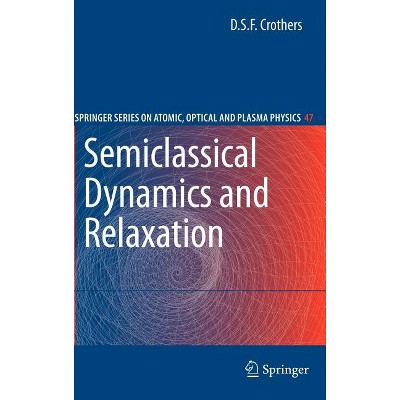Sponsored

Plasma Physics and Controlled Nuclear Fusion - (Springer Atomic, Optical, and Plasma Physics) by Kenro Miyamoto (Hardcover)
In Stock
Sponsored
About this item
Highlights
- The primary objective of these lecture notes is to present the basic theories and analytical methods of plasma physics and to provide the recent status of fusion research for graduate and advanced undergraduate students.
- About the Author: 1955 B.S. Department of Physics, Faculty of Science, University of Tokyo1961 PhD, Graduate School, College of Arts and Science, University of Rochester1963 Doctor of Engineering, University of Tokyo1964 - 1979 Associate Professor and Professor, Institute of Plasma Physics, Nagoya University (former institute of present National Institute of Fusion Science)1979 - 1992 Professor, Department of Physics, Faculty of Science, University of Tokyo1992 - 2000 Professor, Department of Applied Physics, Faculty of Engineering, Seikei University1992 - Professor Emeritus, University of Tokyo1980 - 1988 member of Editorial Board of 'Nuclear Fusion' (Journal pubished by International Atomic Energy Agency)1992 - 2002 Guest Scientist, Japan Atomic Energy Research Institute1999 - 2002 member of ITER Physics Expert Group: ITER (International Thermonuclear Experimental Reactor)
- 372 Pages
- Science, Physics
- Series Name: Springer Atomic, Optical, and Plasma Physics
Description
Book Synopsis
The primary objective of these lecture notes is to present the basic theories and analytical methods of plasma physics and to provide the recent status of fusion research for graduate and advanced undergraduate students. I also hope that this text will be a useful reference for scientists and engineers working in the relevant ?elds. Chapters 1-4 describe the fundamentals of plasma physics. The basic concept of the plasma and its characteristics are explained in Chaps.1 and 2. The orbits of ions and electrons are described in several magnetic ?eld con?gurations in Chap.3, while Chap.4 formulates the Boltzmann equation for the velocity space distribution function, which is the basic equation of plasma physics. Chapters 5-9 describe plasmas as magnetohydrodynamic (MHD) ?uids. The MHD equation of motion (Chap.5), equilibrium (Chap.6) and plasma transport (Chap.7) are described by the ?uid model. Chapter 8 discusses problems of MHD instabilities, i.e., whether a small perturbation will grow to disrupt the plasma or damp to a stable state. Chapter 9 describes resistive instabilities of plasmas with ?nite electrical resistivity. In Chaps.10-13, plasmas are treated by kinetic theory. The medium in which waves and perturbations propagate is generally inhomogeneous and anisotropic. It may absorb or even amplify the waves and perturbations. The cold plasma model described in Chap.10 is applicable when the thermal - locityofplasmaparticlesismuchsmallerthanthephasevelocityofthewave.From the Back Cover
The primary objectives of this book are, firstly, to present the essential theoretical background needed to understand recent fusion research and, secondly, to describe the current status of fusion research for graduate students and senior undergraduates. It will also serve as a useful reference for scientists and engineers working in the related fields. In Part I, Plasma Physics, the author explains the basics of magneto-hydrodynamics and kinetic theory in a simple and compact way and, at the same time, covers important new topics for fusion studies such as the ballooning representation, instabilities driven by energetic particles and various plasma models for computer simulations. Part II, Controlled Nuclear Fusion, attempts to review the "big picture" in fusion research. All important phenomena and technologies are addressed, with a particular emphasis on the topics of most concern in current research.
Review Quotes
From the reviews:
"Plasma Physics and Controlled Nuclear Fusion presents theoretical background in plasma physics needed to understand the fundamentals of nuclear fusion. ... The book is based on lectures given by the author at the graduate level. ... The book provides a thorough overview of the physics of fusion plasmas. ... The book can definitely serve as a reference for scientists and engineers already working in nuclear fusion, who will find the book clear and easy to follow." (Eugenio Schuster, IEEE Control Systems Magazine, Vol. 27, April, 2007)
About the Author
1955 B.S. Department of Physics, Faculty of Science, University of Tokyo
1961 PhD, Graduate School, College of Arts and Science, University of Rochester
1963 Doctor of Engineering, University of Tokyo
1964 - 1979 Associate Professor and Professor, Institute of Plasma Physics, Nagoya University (former institute of present National Institute of Fusion Science)
1979 - 1992 Professor, Department of Physics, Faculty of Science, University of Tokyo
1992 - 2000 Professor, Department of Applied Physics, Faculty of Engineering, Seikei University
1992 - Professor Emeritus, University of Tokyo
1980 - 1988 member of Editorial Board of 'Nuclear Fusion' (Journal pubished by International Atomic Energy Agency)
1992 - 2002 Guest Scientist, Japan Atomic Energy Research Institute
1999 - 2002 member of ITER Physics Expert Group: ITER (International Thermonuclear Experimental Reactor)











